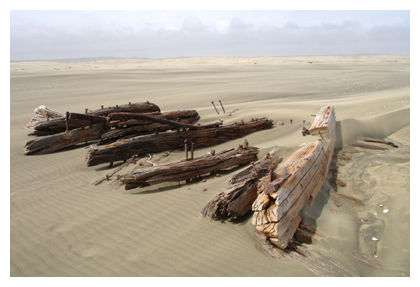
© Ripiro BeachOne of many shipwrecks along the Kaipara Coast
While speculation may still remain as to the identity of a shipwreck found 30 years ago by locals at Pouto Point, near Dargaville, recent radio carbon dating of wood reveals it is New Zealand's oldest shipwreck.
The preliminary findings suggest the ill-fated ship sank around 1705, pre-dating Captain Cook's voyages by some 65 years .
Speaking at the Dargaville Museum this week, dendrochronologist, Dr Jonathan Palmer cautioned that his findings required further work before his research could be confirmed and published.
The wreck was discovered in 1982 by a local team led by Kaipara shipwreck explorer Noel Hilliam. A portion of a cross-member and rib was salvaged by the team, before the wreck was lost back to the sea under 30 metres of sand.
The wood (complete with iron nails) has been confirmed as teak (
tectona grandis) and crepe myrtle (
lagerstromei spp), both tropical woods, likely used for refitting at either Genoa or Java.
Dr Palmer said carbon-dating varied due to radio carbon fluctuations in the atmosphere at any given time.
However, when combined with tree ring sequencing (which gives a better idea of the dates), a series of radio carbon dating on each wood over 10-year periods, the calibration of wiggle matches of the carbon dating, the time allowed for sapwood to be removed and building and rebuilding of the ship, dates become more definitive.
He said the evidence highlighted the possibility of the area being frequented earlier than previously thought.
It is commonly accepted that Dutch explorer Abel Tasman discovered New Zealand in 1642, but finds such as a Spanish helmet in Wellington Harbour and a Tamil bell being used by a Maori tribe as a cooking pot in the mid 1880s suggest the possibility of other exploration of the South Pacific.
Dr Palmer said bitter competition for discovery during the 16th-18th century meant voyages were kept a secret, with many ships sailing with hidden or documented evidence.
However, among references eluding to an earlier knowledge of New Zealand are the British Admiralty maps of 1803 which refer to New Zealand being known to the Portuguese in the 1550s.
Mr Hilliam, who was present at the meeting, said that his 30 years of research since discovering the wreck leads him to believe the ship was the Portuguese Cicilla Maria, but ongoing research of the Spanish and Portuguese archives was still continuing.
However, Dr Palmer said the age of the wood suggested it was not that of the Cicilla Maria which had sailed a century earlier.
Once Dr Palmer's findings are confirmed and published, a display will be erected at the Dargaville Museum.

re History as we know it (scholastic version) will see this particular piece of interest quickly shut down in the lame stream media.
Can't have capt Crooks achievements belittled now can we.